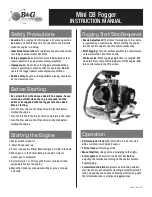
SAMPLE INSPECTION AND MAINTENANCE LOG
The sample log suggests records that should be maintained by the purchaser
or user of life safety equipment.
Equipment Inspection and Maintenance Log
Item __________ # __________ Date in Service ____________
Brand/Model _______________ Strength ___________________
Date How Used or Maintained Comments Name
PUTTING ON THE HARNESS
We recommend the following method for putting on the harness for the most
common situations.
1. Pull the waist loop (yellow) out of the bag. Attach a carabiner to it and clip it
onto the subject’s anchorage point. This could be:
•
To your descender with a Pick Off or Multi-Loop Strap.
•
To a separate rope intended for the subject.
•
To your rope with a Prusik hitch or ascender.
In any situation, the anchorage point should be above the subject
. Tighten
the drawstring so the harness does not inadvertently fall out of the bag.
2. Position yourself adjacent to the subject.
3. Pull the drawstring to open the bag and remove the harness completely out of
the bag. Hold the waist snap buckle in your left hand. The waist loop (yellow)
should be next to your wrist. The “CMC” label should be towards the subject.
4. Reach around and clip the waist V-ring into the waist snap buckle. Center the
waist loop (yellow) to the subject’s front and tighten the waist belt snugly. Take
up any slack in the subject’s belay.
5. Pull the leg loops down, between the legs, and to the outside of the subject’s
body.
6. Clip the V-rings into the snap buckles of the matching color. Pull the ends to
tighten so the leg loops fit snugly. If you are concerned about the buckles
slipping, tie an overhand knot in the end of all the straps.
7. Check the following:
•
The V-rings are securely clipped into each snap buckle.
•
The harness is snug but not pinching or binding.
•
The buckles are not causing the subject any discomfort.
•
All carabiners are locked.
•
All slack is out of the system.
WARNING: To prevent roll out when using carabiners to attach to an
attachment point, use only locking models. If using manual locking
carabiners, verify that they are locked before use. Follow your industry’s
protocol for selecting compatible connectors and system components.
CARRYING, MAINTENANCE & STORAGE
During use, carrying and storage keep the equipment away from acids,
alkalis, exhaust emissions, rust and strong chemicals. Do not expose the
equipment to flame or high temperatures. Carry the equipment where it will be
protected as the equipment could melt or burn and fail if exposed to flame or
high temperatures.
If the equipment becomes soiled, it can be washed in cold water with a mild
detergent that is safe for use with nylon and polyester. Dry out of direct sunlight.
Do not dry in an automatic dryer. Store in a cool, dry location. Do not store
where the equipment may be exposed to moist air, particularly where dissimilar
metals are stored together.
REPAIR
All repair work shall be performed by the manufacturer. All other work or
modifications void the warranty and releases CMC from all liability and
responsibility as the manufacturer.




















